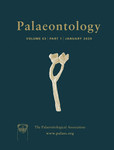Reg. Charity No. 1168330

Tooth replacement in vertebrates is extremely diverse, and its study in extinct taxa gives insights into the evolution of the different dental renewal modes. Based on μ‐CT scans of a left lower jaw of the extinct fish †Scheenstia (Actinopterygii, Lepisosteiformes), we describe in detail a peculiar tooth replacement mode that is, as far as we could ascertain from the literature, unique among vertebrates. The formation of the replacement teeth comprises a 180° rotation of their acrodin cap that occurs intraosseously within bony crypts, and their setting up appears to be synchronous. We propose a model for the dental renewal process and identify complementary anatomical features visible in the tomography such as the junction between the different tooth‐bearing bones (prearticular–coronoid and dentary), as well as cavities corresponding to intraosseous crypts, nervous and/or vascular canals. The location of the cavities and their subsequent identification (e.g. Meckel's cavity, mandibular sensory canal) help us to identify the function of pores visible on the bone surface and understand their relation to internal anatomical features. Finally, recognition of this tooth replacement mode raises the question of whether it is specific to †Scheenstia or related to a particular dentition type and thus potentially occurs in other lineages.
AcknowledgementsWe are thankful to the PalA16 team for the excavation and sampling effort, the elaboration of detailed stratigraphic columns, and especially for the fossil preparation and cast (Renaud Roch), and the photographs of the fossil material (Olivier Noaillon and Bernard Migy). We thank Jérémy Anquetin and Olivier Maridet from the Jurassica Museum in Porrentruy, Switzerland, for kindly realizing the surface scans. Thank you to Torsten Scheyer and Marcelo Sánchez from the Palaeontological Institute and Museum of Zurich (PIMUZH) for providing useful contact and facilitating the first steps of this study. Many thanks to Jorge A. Gonzalez for sharing his knowledge of digital drawing and to Segundo Nuñez Campero for advanced technical support. Thank you to Soledad Gouiric Cavalli for enthusiastic and inspiring talks, and for providing literature. Also, thank you to Jeremías Taborda, Federico ‘Dino’ Degrange and Barbara Bupi for their help with the segmentation. Special thanks go to David Vögel‐Jaramillo (BlueFactory, Fribourg, Switzerland) and Walter Joyce (University of Fribourg, Switzerland) for the μ‐CT scanning of the specimen.
The Paléontologie A16 team (Section d'archéologie et paléontologie) is funded by the Federal Roads Office (FEDRO, 95%) and the Republic and Canton of Jura (RCJU, 5%).
Three anonymous referees commented on an earlier draft of the manuscript and helped to greatly improve it.